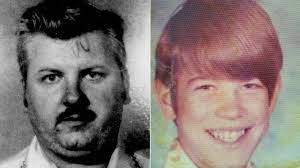
In the ongoing quest for closure, 2023 may mark a crucial turning point in the identification of another victim of the infamous killer John Wayne Gacy, known as the "Killer Clown." Despite Gacy's execution in 1994 after confessing to the murders of 33 young men and boys in the 1970s, the shadows of his crimes persist, particularly with five victims remaining unidentified, according to Cook County Sheriff Tom Dart.
The case, which originally had eight unidentified victims, saw a renewed investigation by the sheriff's office in 2011. Through the application of advanced DNA technology, forensic genetic genealogy, and collaboration with families seeking their missing loved ones, detectives have successfully identified three victims.
Lead investigator Lt. Jason Moran currently pursues a promising lead, although Sheriff Dart acknowledges the uncertainty, stating, "I’m not saying it’s for sure." The investigative team has faced disappointments in the past, even in cases where everything seemed to align, as in a particular instance involving Native American ancestry.
Despite the challenges, progress has been made. The identification of Francis Wayne Alexander as the latest victim, confirmed through DNA samples provided by Alexander's siblings, was announced in 2021. Richard Clyde, the victim's half-brother, expressed relief at the discovery, emphasizing the tragic circumstances surrounding Alexander's fate.
Sheriff Dart reflects on the unexpected outcomes of the ongoing investigation, stating, "When I walked into this thing, it was with the hope we would be able to do one. The fact that we’re three into it, and we’ve also helped identify countless other missing, deceased people is beyond my wildest expectations." The relentless efforts of law enforcement continue to shed light on the dark legacy left by John Wayne Gacy.
Evading Gacy's Grasp
John Wayne Gacy, a seemingly ordinary individual in Norwood Park Township, gained local recognition as a construction contractor, Democratic precinct captain, and a part-time clown entertaining at children's parties. However, his nighttime activities revealed a sinister side as he prowled suburban and Chicago neighborhoods, enticing young men and boys to his home.
Employing a chilling "rope trick," Gacy sexually assaulted and murdered multiple victims, concealing their bodies in a crawl space beneath his house, where lime was used to mask the odors. Gacy's attorney, Sam Amirante, emphasized the ominous reality that having any connection to Gacy increased the likelihood of young men disappearing.
Some managed to escape Gacy's clutches, with Jeff Rignall being a notable example. Gacy lured Rignall into his car in 1978, subjecting him to chloroform, rape, and torture before leaving him unconscious in a Chicago park, as detailed in Rignall's book, "29 Below."
Another survivor, Chicago welder Mickel Ried, briefly lived with Gacy in the early 1970s until an abrupt attack left him with a head injury. During the trial, Ried testified that he had tried to stop Gacy, grabbing his arm as Gacy expressed a desire to kill him.
Gacy's predatory behavior extended to his employees as well. Art Peterson and Dominique Josczinski, both in their 20s and working for Gacy, faced unwanted advances. Peterson, visiting Gacy's house inquiring about a job, experienced Gacy's bisexual advances and threats after breaking away.
Gacy's dark and disturbing actions continued to haunt those who encountered him, revealing the sinister duality beneath his outwardly ordinary facade.
The Wrong Victim
In trying to understand why a serial killer like John Wayne Gacy would allow some of his potential victimsto escape, investigators like Sheriff Tom Dart speculate that various factors might have played a role.
Gacy, known for heavy drinking and drug use, often engaged in risky behaviors, including attempting to have sexual encounters with his victims. Dart suggests that the circumstances surrounding each encounter were complex and dynamic, making it difficult to pinpoint a specific motive.
Despite Gacy's inclination to commit murder whenever an opportunity arose, instances where victims managed to escape were considered fortunate. The unpredictability of these situations could be attributed to Gacy's altered state due to substance abuse and his impulsive actions.
However, Gacy's pattern of evading law enforcement and avoiding suspicion came to an end when he made a critical mistake. His last victim, 15-year-old Rob Piest, stood out from his typical targets. Piest, motivated by a desire for a new car that his part-time job couldn't afford, fell into Gacy's trap when the killer boasted about high wages. Piest entered Gacy's house on December 11, 1978, and tragically never emerged alive.
“His last victim, the Piest boy, was so out of character,” Dart says.
The unusual nature of Piest's disappearance raised alarms, prompting his parents to act swiftly. They engaged in a determined search within their Des Plaines neighborhood, dispelling the notion that Piest was a mere runaway teenager. Detectives, aided by information from pharmacy staff, connected the dots and identified Gacy as the prime suspect.
Pathological Liar
Sheriff Tom Dart has a deep fascination with cold cases, prompting him to encourage his team to identify cases that could benefit from advancements in investigative technologies such as DNA matching and genetic genealogy. Upon Dart's suggestion, Investigator Moran proposed taking on one of the most significant unsolved cases—the Gacy case.
In the 1970s, authorities had attempted to coax the notorious serial killer John Wayne Gacy into revealing the identities of all his victims. However, Gacy, known for being a pathological liar, made it challenging to ascertain the accuracy of any information he provided.
Dart emphasizes that even when Gacy did disclose details, confidence in the truthfulness of his statements was elusive. Moreover, Gacy was often clueless about the identities of some victims, even after assaulting and killing them.
Dart's encounter with Gacy occurred during a prison tour at Illinois' Menard Correctional Center in the 1990s. Gacy's cell left a lasting impression on Dart, resembling a bizarre cage reminiscent of the one in "Silence of the Lambs." Gacy's demeanor was obstinate and unpleasant, marked by confrontational questions such as "who are you?" along with a barrage of expletives, adding to the enigmatic nature of the infamous killer.
Gacy's Killing Spree
Opinions among experts differ on whether John Wayne Gacy had more than 33 victims, but Sheriff Tom Dart is convinced that Gacy's killing spree extended beyond Illinois. Dart bases his belief on evidence such as hotel and gas receipts from various states, challenging the idea that Gacy's criminal activities were confined to a single geographic area.
Dart dismisses the notion that Gacy was limited to a specific region, considering the killer's audacity in committing murders on his home turf. His conviction in Gacy's out-of-state activities solidified when he received an unexpected phone call from an individual in Florida.
According to Dart, the caller recounted a chilling encounter where Gacy had approached him at a Florida truck stop, brandishing a gun. Fortunately, the man managed to escape unharmed by throwing his wallet at Gacy. Remarkably, the identified victim's wallet was later discovered in Gacy's house, validating the account.
To aid in ongoing investigations, the sheriff's office is urging individuals with male relatives missing between 1970 and 1979 to contact them at (708) 865-6244 or fill out an online form on the Cook County Sheriff’s Office website. Despite the passage of years, Dart emphasizes that the lingering impact of "that monster's shadow" is still present, prompting continued efforts to unravel the full extent of Gacy's heinous crimes.
Gacy was arrested on December 21, 1978, and eventually confessed to numerous murders. A comprehensive investigation unearthed the remains of 29 victims in Gacy's crawl space and yard, with an additional four bodies retrieved from the Des Plaines River.
See Also:
